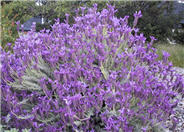
Common name:Spanish Lavender
Botanical name:Lavandula stoechas
This dense shrub grows 2-3 ft. tall with blue gray foliage and deep purple flowers that have large showy bracts near the top of the spikes. It is drought tolerant . - Cornflower Farms

Common name:Bougainvillea Selection
Botanical name:Bougainvillea spectabilis
This species is hardy and vigorous, with a showy, ornamental display of puple color. It blooms well in areas with cool summers. Frost tender.

Common name:Ruby Glow Manuka
Botanical name:Leptospermum scoparium 'Ruby Glow'
New Zealand Tea Tree has small, needle-like green leaves with showy, 1/2" rose-like flowers in winter and spring. These shrubs can be thinned to enhance their attractive branch structure and flaking bark. They need very little water once established. 'Ruby Glow' is compact, upright and grows 6-8' tall by 4-5' wide. It has dark foliage with deep red blooms; it works well as a red accent in the garden.

Common name:Purple Smoke Tree
Botanical name:Cotinus coggygria 'Purpureus'
A deciduous shrub or small tree that grows up to 10' tall, the purpureus is grown for its wispy, thread-like flower clusters and outstanding fall color. Its foliage has a redish purple color that turns somewhat green in summer. The plant requires sun to part shade, with little or no summer water. -Monterey Bay Nursery

Common name:New Zealand Flax
Botanical name:Phormium tenax
New Zealand Flax is a large, bold plant with stiffly vertical, sword-like, green leaves that arise from its base. It should be grown under full sun for best color. Varieties will offer different growth habits and leaf color.

Common name:Jerusalem Sage
Botanical name:Phlomis fruticosa
This hardy perennial is a useful, old-time garden plant with coarse, woolly gray/green, wrinkled leaves and yellow, 1" flowers in ball-shaped whorls. It handles drought and poor soils but needs full sun.
| Designer: | Spanish Lavender Hillside |
Photographer: GardenSoft |
Soils and Compost:
Incorporate compost 6" into your soil to retain water, reduce compaction, feed earthworms, and provide valuable nutrients to your plants.
Water Saving Tip:
Irrigate early in the morning and/or late in the evening to reduce water loss due to evaporation and wind drift.
Integrated Pest Management:
Attract, or buy beneficial insects such as ladybugs and lacewings to control pest outbreaks in your garden.
